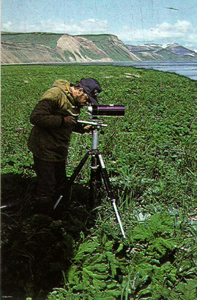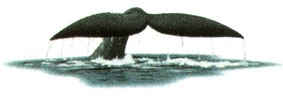 |
REGIONAL INFORMATION DIGESTECONOMY, ECOLOGY, HISTORY, CULTURE |
# 1, 1996
WHALES OF THE SEA OF OKHOTSK IN DAYS OF THE PAST, PRESENT AND FUTURE

Alexander M. BURDIN,
Bachelor of Biological Science. Born in 1955. Graduate of Institute of Agriculture, Hunting Science Faculty. Moved to Kamchatka in 1979. Headed the Pacific Institute for Fisheries and Oceanography Kamchatka Branch Laboratory specializing in sea animal life research. Currently, is heading Higher Vertebrates Ecology Laboratory of Kamchatka Institute of Ecology and Nature Use, Russian Academy of Science.
Thanks to Herman Melwill we do know of Moby Dick's fate. Risking life using small boats and hand weapons, the whalers of the past killed whales in high seas throughout the world. That white sperm-whale made a symbol for whale extermination and antagonisms between Man and Nature. It is really sad to realize that the slaughter of the sea giants continued in our days just the same, making a wide use of powerful fleet and wide range harpoon-guns with explosive charges going off when inside the doomed animals. In the Far East only, five whaling fleets were under full scale operation where the whales were stalked and slain until the last one in a group, giving small or none consideration to size or sex.
That type of operation inadvertently caused a disastrous drop in whale population, and by the 70-s practically nothing left to hunt for.
Happily, nowadays the only reminder of the massive killings of whales, that are easy prey in spite of their size, are debris of the whaling shore camps-rusty whale fat boiling caldrons, long-defunct fat melting furnaces, and whaling crew living quarters.
Despite the recent attempts to assess bigger whale species population in the Far-Eastern seas, effective population control was lost in prior years, to leave scientists barehanded as for the bigger species number, winter stays, favorite breeding locations and reproduction perspectives.
Today, practically all bigger whale species are enlisted in the Russian Red Book and International List of Protected Species (IUCN), although the fact was not instrumental in boosting the further research. Therefore, the endangered species quantities were determined on the basis of expert approximation.
In order to give a more accurate figures on the whale population in the Sea of Okhotsk, a Russian-American Expedition set out in 1995, focused on Gray and Polar Whales. The expedition was the first successful endeavor to resume the research activities, practiced in Russia until the late 80-s.
Our end purpose was to gather as much data on Gray and Polar Whales of the Sea of Okhotsk as possible--take genetic samples via biopsy methods, as well as take pictures of all the whales we would possibly encounter.
The Okhotsk population of Polar Whales (this species is normally known as Greenland Whales) is endemic to the Sea of Okhotsk and isolated from other arctic whale populations of the same species. During a long period the Polar Whales were deemed totally exterminated. However, in recent years, scientists of TINRO (Pacific Research Institute of Fisheries and Oceanography), Doctor of Biological Sciences Alfred Berzin and his colleagues, noted several encounters with the Polar Whales in the Sea of Okhotsk. The largest group concentration registered 72 mammals in the Konstantina Bay, across from the Shantarskiye Islands, in 1988. The contemporary quantity of this population numbers at 200--250 whales, with no data available as a proof of this calculation.
In August of 1995, our expedition undertook study of the Okhotsk Polar Whale population at summer feeding grounds around the Shantarskiye Islands. Two groups were identified counting 10 to 25. The first group, found near the Ukurunru Cape, for the most part consisted of relatively young mammals of medium size. On the helicopter overflight, we clearly identified a Polar Whale female with a baby. We were able to take enough skin samples and make shots in hundreds. That will allow to define this species variations from other populations.
Okhotsk-Korean population of Gray Whale species is aboriginal for the North Pacific region. This population also was considered totally exterminated. However, like in the case with the Polar Whales, Alfred Berzin and his colleagues found the species in the waters surrounding the Northern Sakhalin island, mostly in the Gulf of Pil'tun. The largest ever number of Gray Whales (34) was observed near Sakhalin in September, 1989. Throughout the last decade, sole mammals or groups counting 2--3 were encountered annually near the Southern part of Kamchatka. The total species quantity of the Okhotsk-Korean population is assessed at 150--200 whales, although the actual data is not available as yet.
In June, 1995, in the Gulf of Pil'tun only (North-Eastern part of the Sakhalin Island) 45 Gray Whales were encountered. In August, same year, the helicopter overflight of the Sakhalin Northern Coast yielded another 19 whales on the strip of water as long as 100 kilometers. It was in this area that we first encountered a Gray Whale female with a baby. So, the Gulf of Pil"tun lagoon is a very important feeding ground of this species, which, quite unfortunately, happens to be the main region for natural oil extraction.
Both populations underwent biopsy for skin sampling to do further genetic research. About 800 B&W and colored pictures were taken to make a The Sea of Okhotsk Gray and Polar Whale Identification Catalogue.
Despite the fact that the studied populations consist for a better part of young mammals and newly-borns, the actual quantities in the both populations are conspicuously lower compared to the research evaluation data. Besides, further natural oil and gas developments on the Northern Sakhalin Shelf, together with the plans to construct tidal power stations, and explore other mineral resources, put the existence of these unique species under immediate threat of extinction. The said industrial activity will lead to an irrevocable destruction of the main, and we must note the last, natural habitats of whales.
The industrial development of some of them, for instance, near the West Coast of Sakhalin, is scheduled already for 1996. Floating drill-rigs will be built to operate at depths of 50 to 100 meters. The danger of oil spills, resulting in destruction of bottom sea life--the feeding base of whale species--is very high, more so in the high seismic factor in this region. (Neftergorsk Earthquake is a ready example and a possible scenario).
We think it of an immediate priority to build a system of protected sea areas at the main Okhotsk whale species feeding and reproduction grounds, as well as take measures to eliminate industrial interference and contamination factors. Unless it happens soon, we will get the most of the whales only on photos and videos. How could we possibly be forgiven thereafter?
